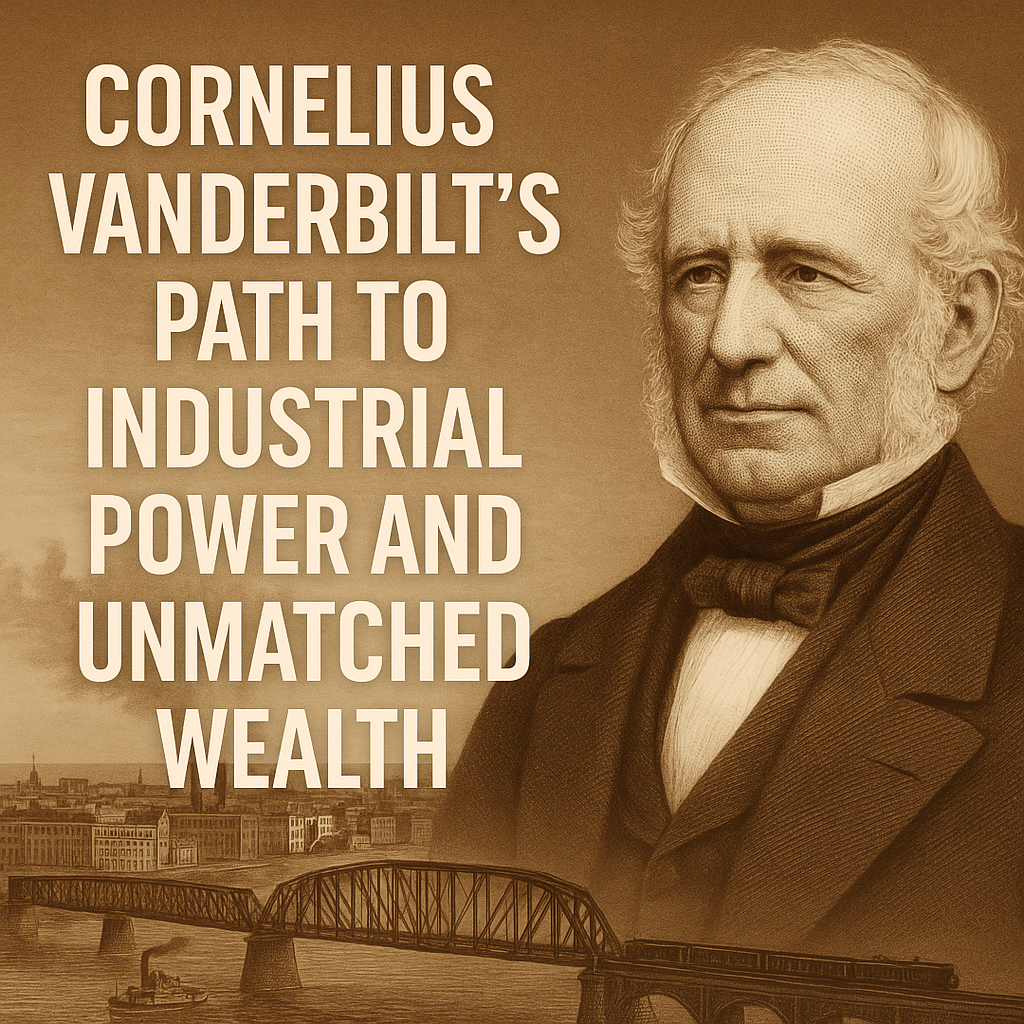Cornelius Vanderbilt rose from humble beginnings to dominate American railroads and shipping, building a fortune that helped shape the modern US economy.
- The Rise From Staten Island To National Fame
- Building A Shipping Empire With Iron Will
- Transitioning From Water To Rail
- Philanthropy And Family Feuds
- The Vanderbilt Legacy In American Capitalism
- Lessons From The Commodore For Today’s Entrepreneurs
- Follow My Journey And Get Inspired To Transform Your Life For The Better
The Rise From Staten Island To National Fame
Cornelius Vanderbilt was born on May 27, 1794, in Port Richmond, Staten Island, New York. His father was a modest boatman who ferried goods and passengers between Staten Island and Manhattan. From a young age, Vanderbilt was exposed to the realities of maritime transport, and though his education was limited—he reportedly left school at age 11—his drive to succeed was boundless.
At 16, he borrowed $100 from his mother to buy a small sailboat, launching his own ferry service in New York Harbor. It was a modest operation, but it revealed the instincts that would define his business career: grit, efficiency, and an appetite for competition. Vanderbilt undercut rival ferry prices and built a reputation for reliability, quickly expanding his fleet.
In the early 1800s, New York’s waterways were essential for both goods and people. Vanderbilt understood this deeply and began mastering the transport of freight and passengers long before the nation had railroads. His focus wasn’t just on service—it was on domination.
By his early 20s, he had caught the attention of Thomas Gibbons, a wealthy steamboat owner locked in a legal battle with Robert Fulton and Robert Livingston, who claimed a monopoly on steamboat traffic in New York waters. Vanderbilt became Gibbons’ business manager and captain, learning not only the technical side of steam navigation but also the legal and political mechanisms necessary to beat monopolies. These lessons would serve him well in decades to come.
Building A Shipping Empire With Iron Will
After parting ways with Gibbons in the late 1820s, Vanderbilt struck out on his own again. He launched new steamboat lines, often competing directly with entrenched operators. His business model was aggressive—he would enter a market, offer superior service at drastically reduced prices, and drive competitors out. Once he dominated a route, he would then raise fares to turn a profit.
Throughout the 1830s and 1840s, Vanderbilt expanded his shipping network along the Atlantic seaboard and into inland waterways. He earned a reputation as the ultimate competitor: tenacious, ruthless, and pragmatic. He had no patience for corporate bureaucracy or partnerships that slowed him down. His focus was speed and scale.
The California Gold Rush of 1849 was another opportunity. Vanderbilt saw the massive demand for transportation from the East Coast to California, and while most companies opted for the long sea route around Cape Horn or an overland slog through the mountains, Vanderbilt launched a shortcut through Nicaragua. His Accessory Transit Company allowed passengers to travel by ship to Nicaragua’s east coast, cross the isthmus by river and stagecoach, and board another ship on the Pacific side to California.
This route was not only faster but also cheaper. It made Vanderbilt millions—and earned him a nickname that stuck for life: “The Commodore.”
His shipping empire eventually stretched from New York to San Francisco, from the Mississippi River to the Caribbean. But while steamships had brought him wealth and influence, he was already eyeing a new frontier that promised even greater power: the railroad.
Transitioning From Water To Rail
By the 1850s, Vanderbilt had amassed tens of millions of dollars from shipping, but the world was changing. Railroads were becoming the arteries of the American economy, and true national power would belong to those who controlled them.
In his 60s—a time when most men retired—Vanderbilt began investing in railroads. He acquired several small and struggling lines around New York, including the Harlem and Hudson River railroads. Many investors dismissed him as a steamboat man out of his depth, but Vanderbilt’s instincts were sharper than ever.
He manipulated stock prices, outmaneuvered rivals in boardroom battles, and modernized the railroad infrastructure. Within a few years, he had gained control of critical northeastern routes, allowing him to link New York City with Chicago, Detroit, and other major cities. His most powerful acquisition was the New York Central Railroad, which became the backbone of his growing empire.
Vanderbilt had no patience for inefficiency. He introduced standardized schedules, cut corruption, and centralized management. These reforms made his railroads faster and more reliable than the competition, and once again, he used underpricing tactics to eliminate rivals.
This aggressive expansion earned him admiration and loathing in equal measure. While business circles respected his sheer willpower and logistical genius, others criticized his cutthroat methods and disregard for workers or smaller competitors. Still, there was no denying his impact—by the 1870s, Vanderbilt controlled the most important rail network in the United States.
Philanthropy And Family Feuds
Despite his reputation as a cold-hearted tycoon, Vanderbilt did not hoard every dollar he earned. Late in life, he began to consider his legacy, both in business and philanthropy.
His most famous donation was to Vanderbilt University in Nashville, Tennessee. He gave $1 million in 1873 (worth tens of millions today) to help establish the university, aiming to foster education and healing in the post-Civil War South. He never visited the campus, but his name has been etched into American educational history ever since.
However, Vanderbilt was far less generous with his family. He had 13 children, and most were either cut off or received only modest inheritances. He had little faith in their ability to manage his empire. Only one son, William Henry Vanderbilt, had proven himself capable, and to him, Cornelius left nearly his entire fortune—estimated at $100 million at the time of his death in 1877.
This decision sparked bitter legal battles and years of animosity within the Vanderbilt family. The Commodore had built a dynasty, but he had also planted the seeds of internal conflict. Ironically, much of the fortune he built would be squandered by later generations in extravagant homes and social climbing.
The Vanderbilt Legacy In American Capitalism
Cornelius Vanderbilt’s impact on American capitalism is hard to overstate. He didn’t just build companies—he helped shape the very idea of what big business could be in the United States.
His model of vertical integration, aggressive pricing, and strategic consolidation became standard practice in industries ranging from steel to oil. Men like Andrew Carnegie and John D. Rockefeller studied his methods and built upon them. Vanderbilt proved that monopolies could be created not just by law, but by sheer will and strategy.
Critics point out that he was a symbol of the Gilded Age’s excesses. He treated labor as expendable, crushed competition, and helped usher in an era of robber barons. But supporters argue that he also laid the groundwork for modern infrastructure and trade. Without his risk-taking and expansion, America’s industrial growth might have taken decades longer.
Today, places like Grand Central Terminal in New York—built by the New York Central Railroad—serve as monuments to his vision. Although the Vanderbilt name would eventually become more associated with luxury and high society, Cornelius himself remained fiercely focused on business until the very end. He never craved aristocratic titles or political power. What he wanted was control.
Lessons From The Commodore For Today’s Entrepreneurs
What can modern entrepreneurs learn from Cornelius Vanderbilt? Despite the vast difference in time and technology, several timeless lessons emerge from his story.
- Start with what you have – Vanderbilt began with a small boat and a big dream. His rise wasn’t fueled by inheritance but by relentless work and risk-taking.
- Master your industry – He didn’t just operate boats or trains; he studied the systems, the competition, the legal frameworks, and the market dynamics.
- Adapt or die – Vanderbilt moved from sail to steam, and from water to rail. He embraced innovation and new opportunities even in his later years.
- Don’t fear competition—use it – Instead of being intimidated by monopolies or established rivals, he entered their markets and forced them to react to him.
- Legacy isn’t just wealth – While he amassed one of the largest fortunes in American history, Vanderbilt also left a lasting legacy in transportation, education, and corporate strategy.
Cornelius Vanderbilt’s story is not a tale of luck or privilege—it’s a story of determination, disruption, and enduring influence. He helped build the infrastructure that would power America into the 20th century and beyond. Whether viewed as a hero of industry or a ruthless capitalist, the Commodore remains one of the most important figures in the story of American business.
I am working on building a passive income stream using the internet. If you would like to do the same take a look at this business by clicking here.
This business can be operated using the internet and the start up cost is low. I don’t have to leave my current employment to work on building this global business.
If you like what you see, work with me to build a passive income stream using this global business.
I do not provide personal investment or financial advice and I am not a qualified licensed investment advisor. I am documenting my online investment and financial journey and what’s working for me. Click Here to read disclaimer.
If you found value in this post and want to support my work, click here to buy me a coffee.
Subscribe to my list for valuable updates, tools, videos and articles that I will share as I come across them.
Let me know your thoughts on this post via the comments section. You can also add your insights and suggestions.
If you enjoyed reading this post or it added some value, please share it with others.

Follow My Journey And Get Inspired To Transform Your Life For The Better
“I may earn commissions as an affiliate from sponsored links within this post”





